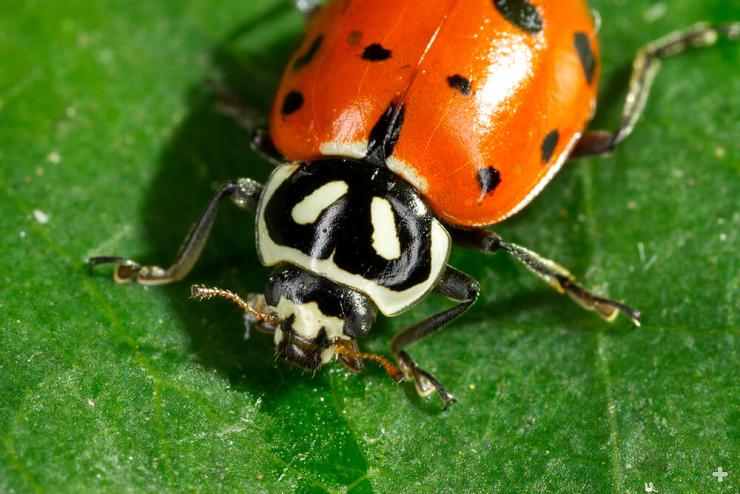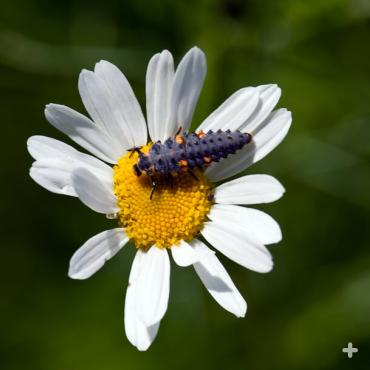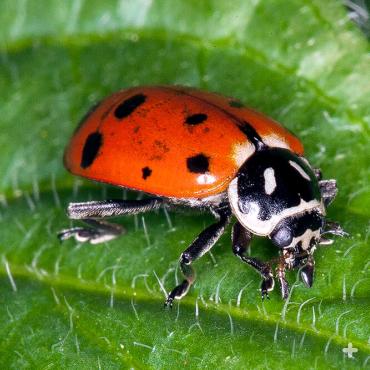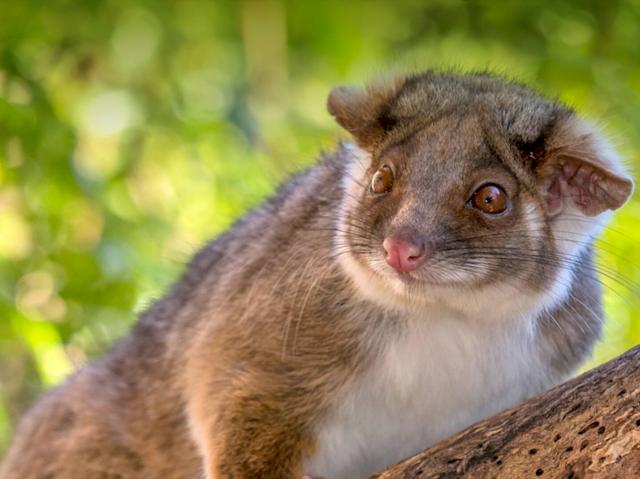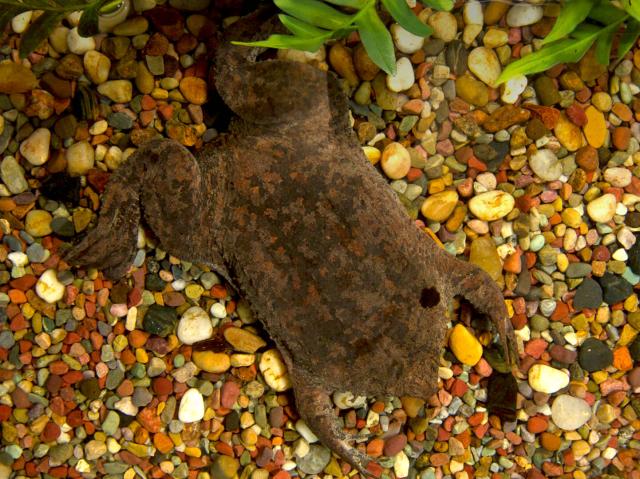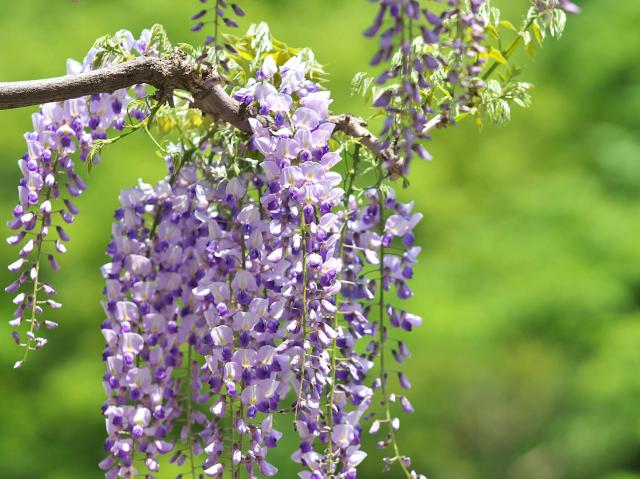
Ladybug

- CLASS: Insecta (Insects)
- ORDER: Coleoptera
- FAMILY: Coccinellidae
- GENERA: 360
- SPECIES: About 5,000 (about 175 in California)

ABOUT
One cute insect: A popular symbol of springtime is the speckled, miniature dome of a ladybug as it strolls along a plant stem looking for its next meal. They are also found in nursery rhymes and folklore around the world. Of all the creepy crawlies, ladybugs are the most beloved and respected of insects.
Lady "bugs" are a group of beetles that are also known as ladybird beetles or lady beetles. In fact, the name ladybug is a slang term for the more correct name, lady beetle. They are harmless to humans and are often considered cute by people who don't like other insects. Some people think ladybugs are a sign of good luck.
Ladybugs are small and usually quite round in shape. The color on the wing covers (elytra) can be yellow, orange, or red and often has small black dots on it. Some species are solid black. Ladybugs also have black legs, head, and antennae.
Like other insects, the ladybug has an exoskeleton made of a protein like the one that forms our hair and fingernails. Its body has three parts: head, thorax, and abdomen. Each of the three body parts has a different function.
The head houses the ladybug’s mouthparts, compound eyes, and antennae. The thorax has three pairs of legs and two pairs of wings. The first pair of wings is the hardened elytra that protect the flight wings underneath. When the ladybug takes flight, the elytra open, and the thin, veined wings unfold. The abdomen contains organs for digestion, respiration, and reproduction. Adult ladybugs breathe air, but the air enters the body through openings, called spiracles, found on the sides of the abdomen and thorax.
Ladybugs gather together in large groups to diapause (the insect term for hibernation). This helps them conserve resources and brings males and females together for reproductive purposes. Some ladybugs gather in logs, buildings, ground cover, beneath snow drifts, and even in houses! Millions gather in the southwestern United States, where they cover the ground like a blanket of red and black.
Ladybugs can survive for up to nine months by living off their stored reserves. They break out of diapause when the temperature reaches 55 degrees Fahrenheit (13 degrees Celsius). This is usually when food becomes available again.
Many ladybugs have bright colors to advertise to predators that they are not worth the effort! If disturbed, they can release a foul-smelling chemical from their "knees" to keep enemies away. Predators learn that color combinations of bright oranges, reds, and blacks can mean an unappetizing taste, and they avoid eating the ladybugs. This works so well that even ladybugs that are not distasteful mimic the colors of the poisonous ones.
Worldwide, ladybugs are seen as omens of good luck. In England, finding a ladybug means there will be a good harvest. In Sweden, if a ladybug lands on a young girl's hand, she will soon be getting married. Ladybugs are the official state insect of Delaware, Massachusetts, New Hampshire, Ohio, and Tennessee. How interesting that such a tiny insect can make such a vast difference in the world!
HABITAT AND DIET

Ladybugs are found almost worldwide, but especially in temperate climates. They can often be seen in forests, gardens, weed patches, and vacant lots full of weeds.
There is nothing ladylike about a ladybug's appetite: an adult may eat up to 75 aphids per day! They also eat other harmful insects like fruit flies, thrips, and mites. Not all ladybugs are carnivorous, but the predatory ones are helpful to gardeners, because they do not damage crops while filling their bellies. In fact, they provide pest-removal services that many growers use instead of pesticides. For this reason, ladybugs can be purchased from many suppliers. More than 100 species of ladybugs are now living in California because of the benefits they provide. Most of the time this is a good thing, but now and then introduced species displace our California natives. We must remember: all things in moderation!
FAMILY LIFE
The female ladybug lays her tiny, golden eggs on the underside of leaves, usually near an aphid colony. In most species, the eggs hatch into larvae that look like caterpillars in just a few days.
Once hatched, the larvae eat about 350 to 400 aphids in the 2 weeks it takes them to become fully grown. As they grow, the larvae shed their skin several times. Once they are a certain size, the larvae stop eating and attach themselves to a plant leaf or stem. They then enter their next developmental stage, called the pupa.
When it is time, the adult ladybug emerges from the pupa. Though it now has all the features of an adult beetle, its exoskeleton is still soft and light in color. It takes the emergent insect several hours for its exoskeleton to harden and darken. A ladybug's entire life cycle only takes three to seven weeks.
AT THE ZOO
Ladybugs are often released on San Diego Zoo and San Diego Zoo Safari Park grounds to help with pest control.
CONSERVATION
Ladybug populations are stable.
LIFE SPAN
Up to 1 year
YOUNG
Number of eggs laid: 3 to 300, depending on species
Incubation period: 5 to 8 days
Age of maturity: 3 to 7 weeks
SIZE
Length: .08 to .4 inches (2 to 10 millimeters), depending on species
FUN FACTS
When ladybugs fly, they beat their wings about 85 times per second.
Not all ladybugs have spots. The Paramysia oblonguttata, for example, is striped, and some species have no spots at all.
A single ladybug larva was observed to have eaten 25 aphids per day for a total of 475 aphids during the course of its larval phase.
Ladybugs have traveled into space. Four ladybugs and a jar of aphids were carried on a space shuttle as part of a zero gravity test to study their movement. The ladybugs were able to capture their prey without the help of gravity.


